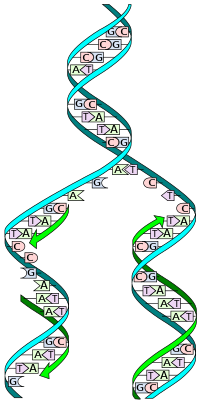
Photo from wikipedia
The reconstituted T4 DNA replication complex serves as the simplest model system to examine the ‘core’ replication mechanisms of higher organisms. In this study we used site-specifically introduced fluorescent base… Click to show full abstract
The reconstituted T4 DNA replication complex serves as the simplest model system to examine the ‘core’ replication mechanisms of higher organisms. In this study we used site-specifically introduced fluorescent base analogues to track local conformational changes of the nucleic acid bases, as well as Cy3/Cy5 dye-pairs inserted into the sugar-phosphate backbones to monitor backbone motions at defined positions within the DNA during interactions of the fork with regulatory proteins. By combining low energy circular dichroism (CD) and fluorescent measurements of the site-specifically introduced fluorescent base analogues with single molecule (sm) FRET experiments with cyanine dyes, we have monitored the binding stoichiometries and interactions of the regulatory proteins with model replication fork constructs. The assembly pathways and binding stoichiometries of gp59 (the helicase loader protein), gp41 (the hexameric helicase) and gp61 (the primase) were studied using functional assays as well as single molecule imaging experiments. The results showed that the stoichiometry of gp59/gp41/gp61 subunits within the functional complex is 1:6:1. CD and fluorescence experiments with base analogue probes show that gp59 preferentially binds to and perturbs the bases at the junction of a forked DNA construct, and that the addition of the gp41 helicase hexamer extends this conformational perturbation deep into the DNA duplex. In contrast, the addition of gp61 perturbs the bases at the fork junction, but not base-pairs deep in the duplex sequence. Based on these results and our previous studies we propose a possible model for DNA duplex unwinding by the helicase loader-primosome-single-strand binding protein complex within the T4 replication system.
Journal Title: Biophysical Journal
Year Published: 2017
Link to full text (if available)
Share on Social Media: Sign Up to like & get
recommendations!